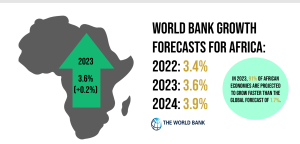Following on from a turbulent half a decade – with the China-US trade war, the COVID-19 pandemic itself plus supply chain disruptions accompanied by inequitable vaccine access, the Russia-Ukraine War and, now, subsequent inflation crisis – many countries across the world in a constrained financial position. The question is, will 2023 and beyond be any different?
Much like the IMF’s most recent economic outlook, the World Bank anticipates the high Cost of Living and Tight Monetary Policies of 2022 spilling over into 2023. As Central Banks around the world “stay the course”, growth will be fragile and hard to come by, making the year ahead another uphill climb.
The latest World Bank Global Economic Prospects Report dives into the forecasts for Africa – and the world’s – future growth. But following on from the IMF’s revised forecasts, is the global economy as “gloom and doom” as headlines suggest, especially for Africa? We believe there are three key takeaways.
- Africa will continue to be a powerhouse of growth. As with the IMF, the World Bank puts Africa as a region ahead of global forecasts – standing at 3.6% and 3.9% for 2023 and 2024, respectively. In 2023 African countries will account for 5 of the world’s top 10 fastest growing economies (Senegal 8%, Niger 7.1%, Cote d’Ivoire 6.8%, Rwanda 6.7%, DRC 6.4%) and in 2024 this will jump to 7 of the world’s fastest-growing economies (Senegal 10.5%, Niger 10.1%, Mozambique 8.1%, Mauritania 7.9%, Rwanda 7%, Cote d’Ivoire 6.6% and DRC 6.6%)
- Despite African economies’ outstanding growth forecasts, there remains serious bias in the IMF and World Bank’s Debt Sustainability Analysis (DSA). Of the World Bank’s top 10 fastest-growing African countries in 2024, 5 countries are also on the latest DSA high/in distress list! Clearly, the DSA needs to be reimagined to account for asset and growth-producing debt.
- With access to concessional finance being made difficult by the DSA, there will continue to be vulnerabilities across all sectors which impact the continent’s long-term economic growth. Take COVID-19 as an example – whilst most Western economies are close to fully vaccinated, the continent still has only 28% of the population fully vaccinated. This is not limited to vaccine access – but other sectors such as African minerals which are extracted and exported to be processed overseas due to the lack of production capacity across the continent.
In sum, whilst African countries and the region look to experience growth in 2023 and beyond, two key shifts are needed. First, more finance – including from the IMF and World Bank – will be needed to ensure that growth can continue and accelerate to achieve long-term, sustainable development. Second, there must be fundamental reform of the International Financial System to stop penalising Borrowing countries, especially when debt can – and has been – growth-producing.

To find out how Development Reimagined can support you, your organisation or Government to review key economic response policies to the COVID19 crisis, the Russia/Ukraine war and other shocks please email the team at clients@developmentreimagined.com.
Special thanks go to Rugare Mukanganga and Jade Scarfe for their work on the graphics, collecting/analysing the underlying data and sharing this accompanying article.
The data was collated from a range of sources including: government websites and media reports, IMF and World Bank data and statista. Our methodology is entirely in-house, based on analysis of economic growth, inflation and other trends.
If you spot any gaps, have any feedback or would like to follow-up on this infographic to request some further information or underlying data, please write to us at interns@developmentreimagined.com, we will aim to respond ASAP!
February 2023


